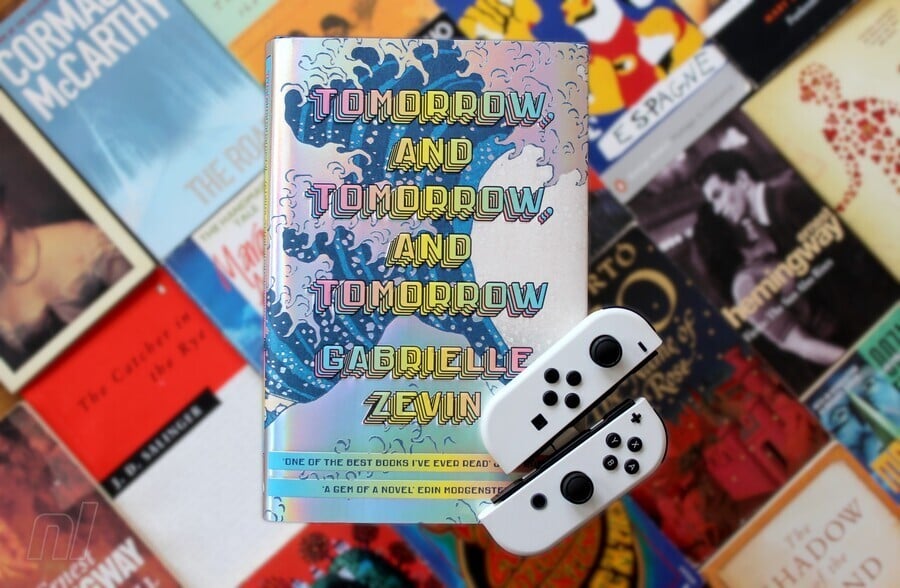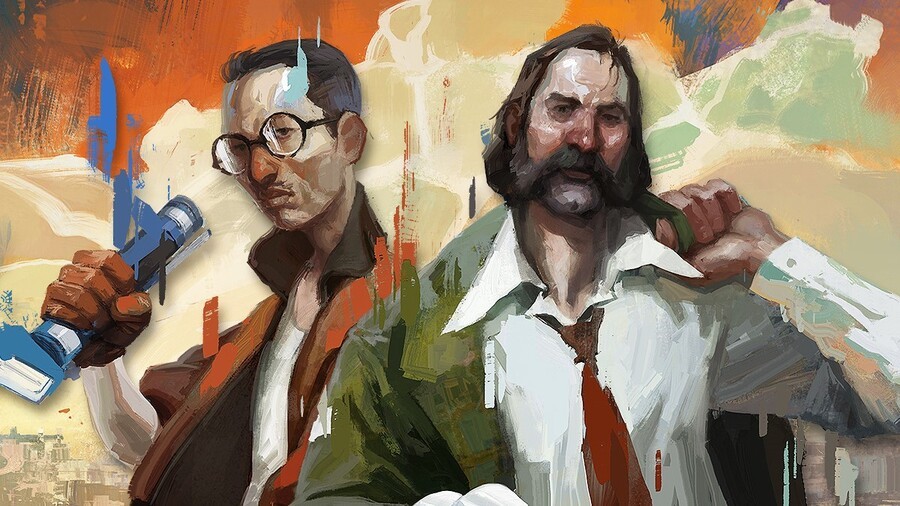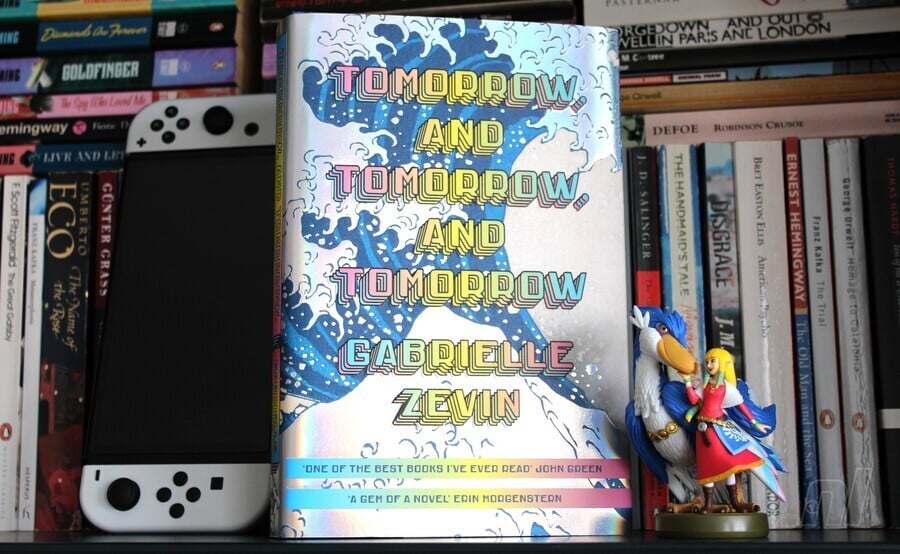
Over the holiday season, we’re republishing select articles from Nintendo Life writers and contributors as part of our Best of 2023 series. Enjoy!

Soapbox features enable our individual writers and contributors to voice their opinions on hot topics and random stuff they’ve been chewing over. Today, Michelle reads an incredible novel about games, and argues that books and games should get on the same page…
Two kids pore over Super Mario Bros. in a hospital game room. One asks the other, ‘What’s the secret to landing high on the flagpole?’ This is the beginning of Sam and Sadie’s friendship, the centrepiece of Gabrielle Zevin’s novel, Tomorrow, and Tomorrow, and Tomorrow.
For anyone who’s tried and struggled with hitting the top of the flagpole, jamming buttons and sighing in frustration, it’s a lovely nostalgic nod to the NES game. For everyone, it’s the beginning of a deep friendship that will play out in the pages of this epic tome.
Tomorrow, and Tomorrow, and Tomorrow is the first book I’d read that took games seriously yet spoke to a mainstream audience.
Tomorrow, and Tomorrow, and Tomorrow charts the friendship of these characters from meeting as kids, to university students making amateur games, to world-famous developers. It offers insightful and funny commentary on creativity and maturity. It’s not a ‘gamer book’ but a book about games; you don’t have to be a capital-G gamer to enjoy it.
Zevin proves a novel can champion characters who play games and can still be read by anyone. But why is this so unique? Where are the books where a character comes home from a long day and unwinds with their Nintendo Switch? (Totally not basing this off my own life). Why aren’t there more books about games?
Google ‘books about games’ and you’ll see non-fiction books (Blood, Sweat and Pixels, Console Wars, art books, encyclopedias), and novels that occupy the sci-fi space (Ready Player One, Snow Crash).

Novels that weave games into a narrative, like T&T&T, are few and far between. Ready Player One, the poster child for game novels, is laden with references that are integral to the reader’s understanding. Its science fiction label is firmly affixed, and it makes no real attempt to make games accessible or appealing to non-game audiences. There’s nothing wrong with that, in theory. But it’s typically the first game novel people think of, and this very fact means that when it comes to books, games still sit somewhere ‘else’, in an arena uninhabited by non-players.
the way mainstream media views games and ‘gamers’ hasn’t changed much since the Game Boy. Zevin pushes against this cliché
I’m sure plenty of aspiring novelists are penning manuscripts like T&T&T, that reference games in a way that’s accessible to anyone. But publishers, like readers, might see such a manuscript, think it’s Ready Player One-A, and toss it in the slush pile. Literature proper still doesn’t reflect the way games are played and consumed in real life. Maybe this is how filmmakers once saw games: a fine medium, sure, but one too otherworldly to be represented as in reality. Yet even as filmmakers improve their relationship with games (more on that later), authors resist. The ‘oldest’ medium has yet to embrace the ‘newest’.
That’s exactly why Tomorrow, and Tomorrow, and Tomorrow is such a — ahem — game-changer.
The literary world might hold up its strongest shield against the games sector, but whatever the reason, its defences should be lowered. Games are more popular than ever. Around 3 billion people play mobile games worldwide. Nintendo Switch sales have surpassed the Game Boy and PS4. During the pandemic, Switches were sold out, and our favourite lockdown island escape Animal Crossing: New Horizons flew off the shelves. Non-gaming news articles might call it a ‘booming’ industry, but it’s already boomed.
And yet the way mainstream media views games and ‘gamers’ hasn’t changed much since the Game Boy. Zevin pushes against this cliché. She gives gamer characters dimensions beyond their playing pleasures.
Sam is raised by his grandparents, and we’re brought into this loving relationship as they care for him, guide him, and give him life advice even when he’s grown. They run a pizza place, which is the setting of Sam’s first gaming (and ‘greatest spiritual’) experience, on a Donkey Kong machine. In Sadie, we see a child who’s concerned for her ill sister/best friend, even while she’s ignored by her parents and forced to grow up at the ripe age of 11. Games become one of the few comforts in her life, even if she can only play for one hour a week. Sam and Sadie are more than gamers – they’re humans.
In the entertainment world, things have been shifting, albeit by inches. Games are on screen more, and players are not just antisocial teenagers. In 2010, Scott Pilgrim vs. The World showed us that video game references could pop up in a widely-loved movie. Apple TV+ show Mythic Quest is a workplace comedy first and a show about games second – it was made to be watched by not-just-gamers. Game adaptations have been improving, and appealing to people who have never touched a console (think The Last of Us, The Witcher, Arcane, and the upcoming Tetris biopic and Super Mario Bros. Movie).
Playing and reading share a sort of intimacy, too. In T&T&T, Sam says, ‘There is no more intimate act than play, even sex’
Increasingly, games of all sizes are based around more complex narratives with multi-dimensional characters. I find plot to be a major drawcard for play and purchase. For me, emotional investment makes achieving that final boss fight, that final quest, that evaluation from Grandpa, even sweeter.
There are even games that mirror books, such as Disco Elysium (created by novelist Robert Kurvitz) and Beacon Pines. Both are largely text-based, prompting readers’ imaginations the way a novel does.
Playing and reading share a sort of intimacy, too. In T&T&T, Sam says, ‘There is no more intimate act than play, even sex’ (!) When you spend so much time getting to know characters and sharing their pursuits, it’s impossible not to care about their lives and ambitions.
That intimacy gives the consumer an active role in progressing the story. If you leave the room while a film plays, it keeps going. But books and games need you to move the story along – whether it be by turning pages or pressing buttons. And player-readers like me do this for both, with the same just a little longer fervour.

Tomorrow, and Tomorrow, and Tomorrow is the first book I’ve read that took video games seriously while also speaking to a mainstream audience. It also made me laugh, cry and google everything about it. The gripping story and broad appeal make for such a perfect union of the oldest and newest media that it could influence the wider conversation about games in the literature space. Now that its acclaim is growing (and it’s being adapted into a film, of course), we could see a greater presence of games in literary worlds.
That’s a tomorrow I look forward to.
Over the holiday season, we’re republishing select articles from Nintendo Life writers and contributors as part of our Best of 2023 series. Enjoy!

Soapbox features enable our individual writers and contributors to voice their opinions on hot topics and random stuff they’ve been chewing over. Today, Michelle reads an incredible novel about games, and argues that books and games should get on the same page…
Two kids pore over Super Mario Bros. in a hospital game room. One asks the other, ‘What’s the secret to landing high on the flagpole?’ This is the beginning of Sam and Sadie’s friendship, the centrepiece of Gabrielle Zevin’s novel, Tomorrow, and Tomorrow, and Tomorrow.
For anyone who’s tried and struggled with hitting the top of the flagpole, jamming buttons and sighing in frustration, it’s a lovely nostalgic nod to the NES game. For everyone, it’s the beginning of a deep friendship that will play out in the pages of this epic tome.
Tomorrow, and Tomorrow, and Tomorrow is the first book I’d read that took games seriously yet spoke to a mainstream audience.
Tomorrow, and Tomorrow, and Tomorrow charts the friendship of these characters from meeting as kids, to university students making amateur games, to world-famous developers. It offers insightful and funny commentary on creativity and maturity. It’s not a ‘gamer book’ but a book about games; you don’t have to be a capital-G gamer to enjoy it.
Zevin proves a novel can champion characters who play games and can still be read by anyone. But why is this so unique? Where are the books where a character comes home from a long day and unwinds with their Nintendo Switch? (Totally not basing this off my own life). Why aren’t there more books about games?
Google ‘books about games’ and you’ll see non-fiction books (Blood, Sweat and Pixels, Console Wars, art books, encyclopedias), and novels that occupy the sci-fi space (Ready Player One, Snow Crash).

Novels that weave games into a narrative, like T&T&T, are few and far between. Ready Player One, the poster child for game novels, is laden with references that are integral to the reader’s understanding. Its science fiction label is firmly affixed, and it makes no real attempt to make games accessible or appealing to non-game audiences. There’s nothing wrong with that, in theory. But it’s typically the first game novel people think of, and this very fact means that when it comes to books, games still sit somewhere ‘else’, in an arena uninhabited by non-players.
the way mainstream media views games and ‘gamers’ hasn’t changed much since the Game Boy. Zevin pushes against this cliché
I’m sure plenty of aspiring novelists are penning manuscripts like T&T&T, that reference games in a way that’s accessible to anyone. But publishers, like readers, might see such a manuscript, think it’s Ready Player One-A, and toss it in the slush pile. Literature proper still doesn’t reflect the way games are played and consumed in real life. Maybe this is how filmmakers once saw games: a fine medium, sure, but one too otherworldly to be represented as in reality. Yet even as filmmakers improve their relationship with games (more on that later), authors resist. The ‘oldest’ medium has yet to embrace the ‘newest’.
That’s exactly why Tomorrow, and Tomorrow, and Tomorrow is such a — ahem — game-changer.
The literary world might hold up its strongest shield against the games sector, but whatever the reason, its defences should be lowered. Games are more popular than ever. Around 3 billion people play mobile games worldwide. Nintendo Switch sales have surpassed the Game Boy and PS4. During the pandemic, Switches were sold out, and our favourite lockdown island escape Animal Crossing: New Horizons flew off the shelves. Non-gaming news articles might call it a ‘booming’ industry, but it’s already boomed.
And yet the way mainstream media views games and ‘gamers’ hasn’t changed much since the Game Boy. Zevin pushes against this cliché. She gives gamer characters dimensions beyond their playing pleasures.
Sam is raised by his grandparents, and we’re brought into this loving relationship as they care for him, guide him, and give him life advice even when he’s grown. They run a pizza place, which is the setting of Sam’s first gaming (and ‘greatest spiritual’) experience, on a Donkey Kong machine. In Sadie, we see a child who’s concerned for her ill sister/best friend, even while she’s ignored by her parents and forced to grow up at the ripe age of 11. Games become one of the few comforts in her life, even if she can only play for one hour a week. Sam and Sadie are more than gamers – they’re humans.
In the entertainment world, things have been shifting, albeit by inches. Games are on screen more, and players are not just antisocial teenagers. In 2010, Scott Pilgrim vs. The World showed us that video game references could pop up in a widely-loved movie. Apple TV+ show Mythic Quest is a workplace comedy first and a show about games second – it was made to be watched by not-just-gamers. Game adaptations have been improving, and appealing to people who have never touched a console (think The Last of Us, The Witcher, Arcane, and the upcoming Tetris biopic and Super Mario Bros. Movie).
Playing and reading share a sort of intimacy, too. In T&T&T, Sam says, ‘There is no more intimate act than play, even sex’
Increasingly, games of all sizes are based around more complex narratives with multi-dimensional characters. I find plot to be a major drawcard for play and purchase. For me, emotional investment makes achieving that final boss fight, that final quest, that evaluation from Grandpa, even sweeter.
There are even games that mirror books, such as Disco Elysium (created by novelist Robert Kurvitz) and Beacon Pines. Both are largely text-based, prompting readers’ imaginations the way a novel does.
Playing and reading share a sort of intimacy, too. In T&T&T, Sam says, ‘There is no more intimate act than play, even sex’ (!) When you spend so much time getting to know characters and sharing their pursuits, it’s impossible not to care about their lives and ambitions.
That intimacy gives the consumer an active role in progressing the story. If you leave the room while a film plays, it keeps going. But books and games need you to move the story along – whether it be by turning pages or pressing buttons. And player-readers like me do this for both, with the same just a little longer fervour.

Tomorrow, and Tomorrow, and Tomorrow is the first book I’ve read that took video games seriously while also speaking to a mainstream audience. It also made me laugh, cry and google everything about it. The gripping story and broad appeal make for such a perfect union of the oldest and newest media that it could influence the wider conversation about games in the literature space. Now that its acclaim is growing (and it’s being adapted into a film, of course), we could see a greater presence of games in literary worlds.
That’s a tomorrow I look forward to.






